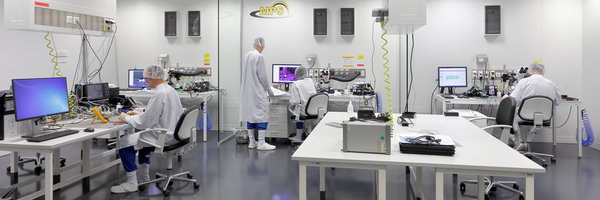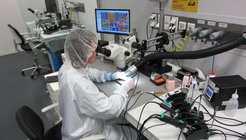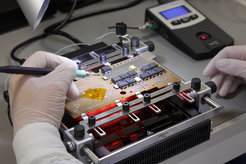
Electronics Laboratory
The Electronics Lab of the MPS has a key role in the experimental research work of the institute. Here, the instruments for ground- and space-based applications are developed, assembled, integrated, tested, calibrated and qualified. The staff members in the electronics department closely collaborate with the engineers in the scientific departments. For example, they produce complex electronic circuit boards with up to ten layers and subsequently proceed with the population of the boards, testing of the circuit and finally its commissioning.

All technicians taking care of these tasks possess an ESA certificate for qualified soldering, which is re-taken every two years. They work at soldering stations that are equipped for flight hardware and that are insulated against electric discharges. All state-of-the-art soldering techniques are handled, from through-hole technology, surface mount devices up to the specialties of hyperfrequency technology. To maintain the high-quality levels of space electronics, the printed circuit boards will be exclusively populated by hand soldering and each solder joint being inspected and checked by an independent expert. Soldering of more complex and complicated electronics parts is alternatively done by the vapor-phase soldering technology. Here also, the quality control by inspection of all solder joints is part of the standard workflow.
Cable harnesses are the lifelines of the scientific instruments. The development and manufacturing of the harnesses also fully complies with the requirements for space electronics. For producing space qualified cables, all necessary equipment and ESA-certified staff is available.

Furthermore, in the electronics lab, FPGAs (Field Programmable Gate Arrays) are programmed in VHDL (Very High Speed Integrated Circuit Hardware Description Language) in the direct line with the hardware development. Beyond the hardware related programming, the development of instrument software, control algorithms and measurement routines providing the connection back into the scientific projects. Later on in the projects context, the instruments or subsystems will be characterized and qualified on their transfer characteristics or their susceptibility to electromagnetic interferences in well-equipped and controlled laboratory environments.
In the Apprentices Workshop of the Electronics Laboratory, each year one apprentice finishes the 3.5 years training for a skilled electronics worker.

